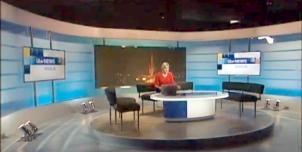Full Freeview on the Tacolneston (Norfolk, England) transmitter
| Google Streetview | Google map | Bing map | Google Earth | 52.518,1.139 or 52°31'6"N 1°8'22"E | NR16 1DW |
The symbol shows the location of the Tacolneston (Norfolk, England) transmitter which serves 330,000 homes. The bright green areas shown where the signal from this transmitter is strong, dark green areas are poorer signals. Those parts shown in yellow may have interference on the same frequency from other masts.
_______
Digital television services are broadcast on a multiplexes (or Mux) where many stations occupy a single broadcast frequency, as shown below.
64QAM 8K 3/4 27.1Mb/s DVB-T MPEG2
DTG-12 QSPK 8K 3/4 8.0Mb/s DVB-T MPEG2
H/V: aerial position (horizontal or vertical)
Which Freeview channels does the Tacolneston transmitter broadcast?
If you have any kind of Freeview fault, follow this Freeview reset procedure first.Digital television services are broadcast on a multiplexes (or Mux) where many stations occupy a single broadcast frequency, as shown below.
64QAM 8K 3/4 27.1Mb/s DVB-T MPEG2
DTG-12 QSPK 8K 3/4 8.0Mb/s DVB-T MPEG2
H/V: aerial position (horizontal or vertical)
Which BBC and ITV regional news can I watch from the Tacolneston transmitter?

BBC Look East (East) 0.8m homes 3.2%
from Norwich NR2 1BH, 16km northeast (37°)
to BBC East region - 27 masts.
70% of BBC East (East) and BBC East (West) is shared output

ITV Anglia News 0.8m homes 3.2%
from NORWICH NR1 3JG, 16km northeast (38°)
to ITV Anglia (East) region - 26 masts.
All of lunch, weekend and 80% evening news is shared with Anglia (West)
Are there any self-help relays?
| Gt Yarmouth | Transposer | 1 km S town centre | 30 homes |
| Lowestoft (2) | Transposer | Rotterdam Rd | 125 homes |
How will the Tacolneston (Norfolk, England) transmission frequencies change over time?
| 1950s-80s | 1984-97 | 1997-98 | 1998-2011 | 2011-13 | 2013-18 | 2013-17 | 17 Jul 2018 | ||
| VHF | C/D E | C/D E | C/D E | E | E T | W T | W T | ||
| C3 | BBCtvwaves | ||||||||
| C31 | com7 | com7 | |||||||
| C32 | _local | ||||||||
| C37 | com8 | com8 | |||||||
| C39 | +ArqB | +ArqB | ArqB | ||||||
| C40 | BBCA | ||||||||
| C42 | SDN | SDN | SDN | SDN | |||||
| C43 | D3+4 | ||||||||
| C45 | ArqA | ArqA | ArqA | ArqA | |||||
| C46 | BBCB | ||||||||
| C50tv_off | BBCB | BBCB | |||||||
| C52tv_off | C5waves | C5waves | |||||||
| C55tv_off | BBC2waves | BBC2waves | BBC2waves | -BBCA | -BBCA | -BBCA | com7tv_off | ||
| C56tv_off | COM8tv_off | ||||||||
| C57tv_off | LNR | LNR | |||||||
| C59tv_off | ITVwaves | ITVwaves | ITVwaves | -D3+4 | -D3+4 | -D3+4 | |||
| C62 | BBC1waves | BBC1waves | BBC1waves | BBCB | |||||
| C65 | C4waves | C4waves | C4waves |
tv_off Being removed from Freeview (for 5G use) after November 2020 / June 2022 - more
Table shows multiplexes names see this article;
green background for transmission frequencies
Notes: + and - denote 166kHz offset; aerial group are shown as A B C/D E K W T
waves denotes analogue; digital switchover was 9 Nov 11 and 23 Nov 11.
How do the old analogue and currrent digital signal levels compare?
| Analogue 1-4 | 250kW | |
| SDN, ARQA, ARQB, BBCA, D3+4, BBCB | (-4dB) 100kW | |
| com7 | (-9.6dB) 27.4kW | |
| com8 | (-10.2dB) 24kW | |
| Mux 1*, Mux 2*, LNR | (-14dB) 10kW | |
| Mux A*, Mux B*, Mux C*, Mux D* | (-17dB) 5kW | |
| Analogue 5 | (-18dB) 4kW |
Local transmitter maps
Tacolneston Freeview Tacolneston DAB Tacolneston TV region BBC East Anglia (East micro region)Which companies have run the Channel 3 services in the Tacolneston transmitter area
|
|
Sunday, 13 February 2011
P
ParishPete10:42 PM
I note that the signal strength gets a major boost at switchover.
Presently I have to use both a pre booster and an 8 way boster to each outlet.
If the new signal is so strong will I need to tone down (or even turn off) my boosters?
Pete
| link to this comment |
Monday, 14 February 2011
ParishPete: Yes, you should remove any booster you have at switchover.
Normally simply removing the power will block the signal, you will need to remove and bypass the booster.
| link to this comment |
Wednesday, 16 February 2011
A
abbey television2:46 PM
when will the norwich relay transmitter provide digital,will it include all digital chan's unlike some relays.we need to tell our customers. paul.
| link to this comment |
abbey television: As above Wednesday, 9th/23rd November 2011. See Norwich Central digital switchover date | ukfree.tv - independent free digital TV advice .
| link to this comment |
M
Mike Dimmick6:47 PM
Reading
abbey television: and no, it will only provide the three public-service multiplexes. The commercial multiplex operators have turned down the option to broadcast from any more sites than the 81 main transmitters they already broadcast from.
| link to this comment |
Mike's: mapM's Freeview map terrainM's terrain plot wavesM's frequency data M's Freeview Detailed Coverage
Monday, 21 February 2011
M
mark hawes5:38 PM
wondered if you could help me? i have a horizon hd-tm plus terrestrial meter and was wondering what signal strength is the least and what is the most i have to have for tacolneston transmitter? also it has 16qam or 64qam,which one does my meter have to be set on? as im still learning it would be appreciated if you could help me please? also will there be any need for amplifiers when analogue is switched off?Many thanks Mark.
| link to this comment |
mark hawes: The modes are listed for each multiplex above.
Amplifiers should be removed at switchover, they do nothing but cause problems with digital signals.
| link to this comment |
Tuesday, 22 February 2011
M
mark hawes8:18 AM
thanks for answering my question above,but can you tell me what levels in dbuv i will be looking for digital? whats the least? whats the most from tacolneston?Many thanks mark.
| link to this comment |
mark hawes: The signal you will receive depends on your distance from the transmitter - it is the ERP listed divided by the distance squared.
45 to 65 dBuV is the typical range for Freeview reception, 33.4 dBuV being the absolute minimum.
| link to this comment |
M
mark hawes8:47 AM
thanks very much for your help,if i have anymore questions i will be in touch.Cheers mark.
| link to this comment |
Select more comments
Your comment please!





